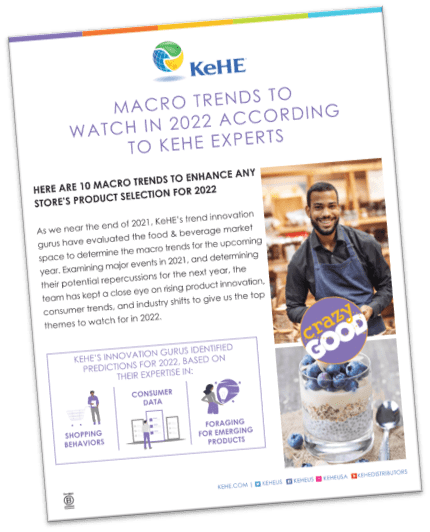
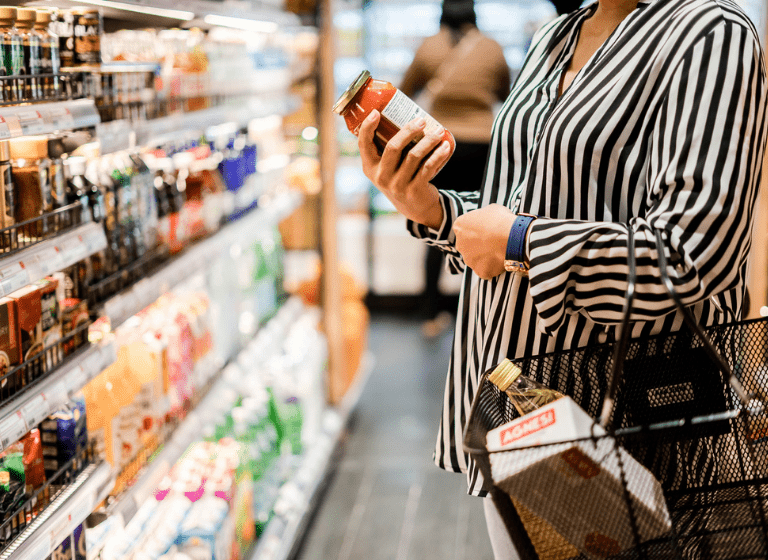
Ten Macro Trends to Watch in 2022 According to KeHE Experts
As we near the end of 2021, KeHE’s trend innovation gurus have evaluated the food & beverage market space to determine the macro trends for the upcoming year. Examining major events in 2021, and determining their potential repercussions for the next year, the team has kept a close eye on rising product innovation, consumer trends, and industry shifts to give us the top themes to watch for in 2022.
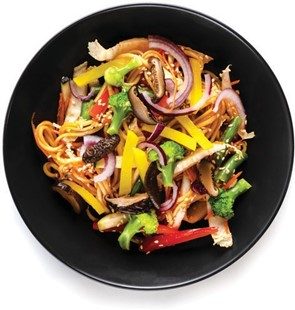
Food Adventuring
While consumers find comfort in traditional and familiar flavors, unexpected and unique twists in taste are enticing more and more consumers. Cuisine exploration is on the rise as consumers look to travel the world through their tastebuds with newer trending flavors like yuzu, hibiscus, ube, and tzatziki.
As restaurant restrictions lifted this past year and consumers look to explore cultural diversity, it is a good time for brands to share authentic cuisine from around the world with others. While Mexican, Italian, and Chinese cuisines dominate as the most reached international cuisine types, younger generations, like Gen Z, are driving consumption of African and Mediterranean cuisines and bridging the gap of mainstream and emerging international dishes.
Food Tech Boom
In recent years, there has been a rise in plant-based meats and sugar substitute demand. However, those mainstream substitutes and meat alternatives are not cutting it. Consumers are also demanding simpler and real ingredients from brands. In the next year, KeHE experts predict the continued rise of plant-based varieties such as ready-to-eat meats and alternatives for eggs, an increase in demand for allulose as a sugar replacement, and new categories utilizing food technology.
Sober Curious
“Sober-curious” or “mindful drinkers” are KeHE coined terms referring to those that are abstaining or selecting alcohol-free options. The rise of this trend stems from the cultural dominance of mindfulness, legalization of alternatives to alcohol, deepening health & wellness understandings, along with shifting spaces of consumption and ways of socialization. In fact, 31% of adults over the age of 22 consumed an alcoholic beverage less than once per month or not at all over the last three months. A large driver of the trend is Gen Z, with 24% saying they do not drink alcohol often or at all when dining out because of health reasons.

Dual Purpose
These days it is not enough to just taste good, consumers are now looking for more from a brand. Specifically, shoppers have become increasingly concerned about how their food purchases impact the environment. They are looking for upcycled, zero waste, reduced carbon footprint, and water reduction in the products they purchase. While still emerging as a trend, consumers are also looking at farming practices, looking at regenerative agriculture – the practice of increasing soil biodiversity and organic matter, leading to more resilient soil that can better withstand climate change impacts without the need for synthetic fertilizers and/or pesticides.
Convenience Continues
The pandemic restrictions to stay at home have caused a lasting impact on some consumers and their eating habits. 53% of US consumers who cooked using convenience foods and followed set meal routines more often due to the pandemic, plan to maintain these habits. Anticipating continuing these convenience at-home food habits, they are looking for time-saving products and grab-and-go snacks. Along with that, quality ingredient and chef-inspired frozen meals, home delivery meals, and refrigerated appetizers & entrees are expected to continue in growth as consumers look for quick lunches or dinners to be made at home or away from home.
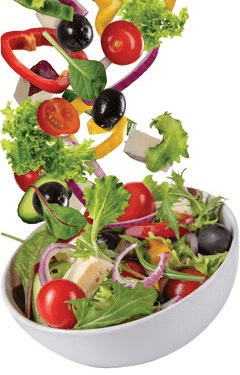
Blurring Diet Lines
Sparked by habits adopted during the pandemic, consumers are looking to be more proactive with their health while remaining flexible in their diets. This has led to the trend of picking and choosing from diet fads and customizing it to the consumer’s personal need. Shoppers are no longer following strict diets, rather they are cherry-picking what best suits their bodies. For example, choosing to eat more of a flexitarian diet with less meat and more plants rather than committing to becoming a vegan or vegetarian. This holds true for other popular diets like Keto as well, choosing lower carb over low carb.
Permissible Indulgence
Evolving their definition of what qualifies as a snack, consumers are increasingly seeking permissibly indulgent options. Shoppers are looking for guilt-free food indulgence by looking at ingredient & nutritional callouts that make an item feel both decadent and healthy. In fact, 69% of consumers say they want the best of both worlds, looking for snacks to balance health and taste.

Growing Your Local Community
The local movement is more than just food – it is a significant shift in why, where, and how we consume. Currently, 65% of Americans try to buy from local companies when possible and one in three millennials say purchasing local is a top priority for them. The need for local products not only comes out of necessity, with certain products not available due to mass supply chain issues experienced over the last two years, but also because shoppers are more than ever looking to feel connected through their community. By adding in local vendors and drawing attention to those products using signage and shelf tags, stores can build a sense of unity and pride for their shoppers.
Getting Grain-ular
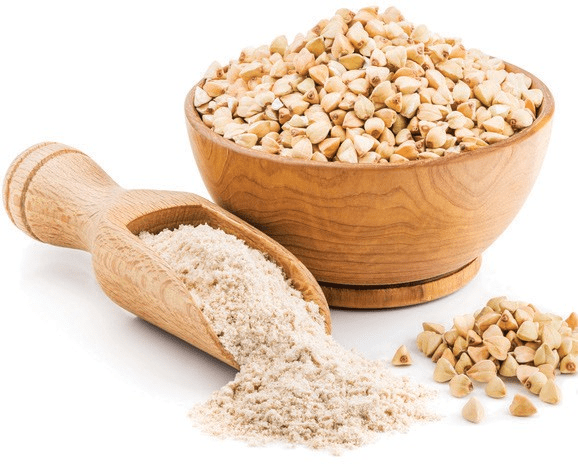
As one of the healthiest grains on earth, with the combined power of wholesomeness and affordability, it is no surprise that oats are coming up on top. Over the last several years, we have seen a growth in popularity of oat milk which has sparked interest in other categories as an alternative ingredient, including frozen & refrigerated desserts, cheese, butter, spreads, and even oat protein. While consumers are going oat-crazy, other grain innovation has entered the market. KeHE experts predict the rise of barley, hemp, pistachio, and buckwheat as future grain and seed alternatives.
Functionality Collab
Macroeconomic issues, such as inflation, rising food prices, and supply chain shortages have sparked a change in consumer behavior – looking to get the most out of the food or beverage. One way is through functional attributes in everyday products. Ingredients that are found to be naturally beneficial or boost immunity, are now being found in new category segments. For example, mushrooms are continuing to expand in popularity as a functional ingredient, entering the beverage, coffee, creamer, and snacking categories.
What’s Next?
For more food & beverage trends, follow us on our social media platforms. Our innovation gurus are always on the lookout for category trends and exciting new products. Discover more at https://www.kehe.com/news-blog/
Emerging brands can submit new products to KeHE’s Category Management team on https://www.kehe.com/work-with-kehe/
KeHE Customers, reach out to your sales representative for help implementing these trends into your store.

